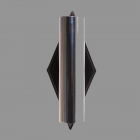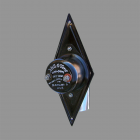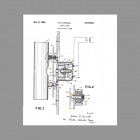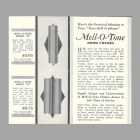Mell-O-Tone Model E
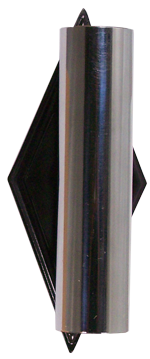
Mell-O-Tone Model E ~1933
The Mell-O-Tone Model E door chime features a concealed solenoid unit to provide a more streamlined aesthetic. Installation required a two and one half inch diameter and three inch deep recess in the wall for the electrical connections leaving only the tone bar, chromed resonator tube and a decorative diamond-shaped escutcheon plate to show on the wall.
The patent described the chime:
The chime device embodying my invention is adapted to be mounted upon a wall and to have the operating structure embedded within the wall. To this end, I employ a vertically disposed chime bar 10, a tubular resonator 11, preferably closed at the ends, and which has an opening 12 disposed in front of the bar and between the points of the support 13 and 14, respectively. Such supports preferably comprise posts 15 which connect the resonator with an escutcheon plate 41 which is adapted to be attached to the wall by any securing means.
Consistent with the marketing of other door chimes from the 1930s through the 1950s, Mell-O-Tone marketed their chimes against the shrill sound of the doorbells and buzzers they aimed to replace:
How often has the peace and quiet of your home been distubrbed by the shrill, nervy-racking ringing of a door bell? Has your door bell ever gone out of order at just the wrong time, causing confusion and embarrassment?
Frankly, there’s no place in life for such trivial things as “door bell problems.” That is why modern households rely on the soft, ,eloduous call of Mell-O-Tone door chimes to announcement visitors.
Mell-O-Tone was just one of many early manufacturer’s using “mello” in their name. Surviving examples of Mell-O-Tone products are scarce as this is the only example I’ve seen.
The Model E rings on a single steel tone bar while a similar Model D plays achord on two bars.
Manufacturer National Signal Systems Location of Manufacture Cleveland, Ohio Date of Manufacture ~1933 Cover Stamped steel Mechanism Stamped steel Resonators Chromed brass Tone bars Painted steel Height 8 1/2 inches Width 3 1/2 inches Depth 4 7/8 inches (2 5/8 inches beyond wall. 2 1/4 inches recessed. ) Notes Restored for homeowner in Washington State.
